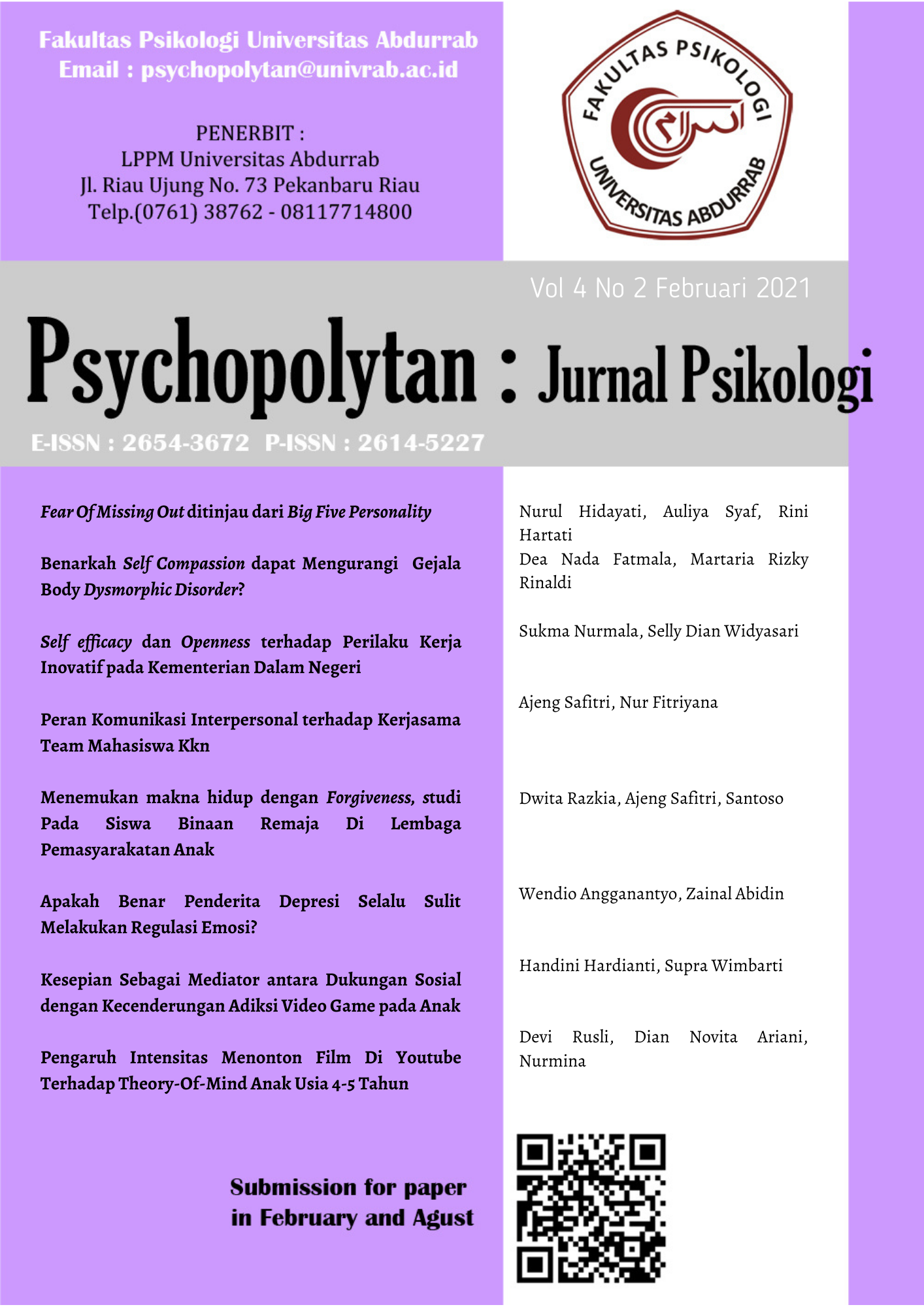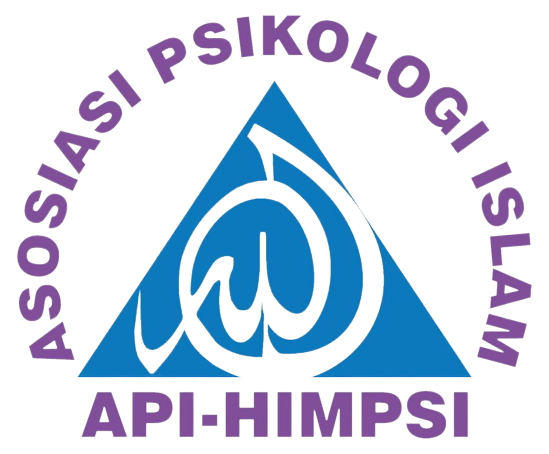Benarkah Self Compassion dapat Mengurangi Gejala Body Dysmorphic Disorder?
(Submitted 16 September 2020) (Published 28 Februari 2021)
DOI:
https://doi.org/10.36341/psi.v4i2.1480Keywords:
self compassion, body dysmorpic, remajaAbstract
Penelitian ini bertujuan untuk mengetahui hubungan antara self compassion dengan gejala body dysmorphic disorder pada remaja putri. Hipotesis yang diajukan dalam penelitian ini adalah ada hubungan negatif antara self compassion dengan gejala body dysmorphic disorder. Subjek dalam penelitian ini ber jumlah 105 orang. Pengambilan subjek menggunakan purposive sampling, data dikumpulkan menggunakan skala Self Compassion dan skala Gejala Body Dysmorphic Disorder. Analisis data penelitian ini menggunakan korelasi product moment dari Pearson. Berdasarkan hasil analisis, diperoleh koefisien korelasi (rxy) = -0,336 (p<0,005). Hasil tersebut menunjukkan bahwa terdapat hubungan negatif yang signifikan antara self compassion dengan gejala body dsymorphic disorder. Artinya semakin tinggi self compassion yang dilakukan individu maka semakin rendah gejala body dysmophic disorder yang dimilikinya, sebaliknya semakin rendah self compassion maka semakin rendah gejala body dysmorphic disorderyang dimiliki individu. Koefisien determinasi (R2) yaitu 0,113 yang menunjukkan sumbangan efektif 11,3% dari self compassion untuk gejala body dysmorphic disorder.
Downloads
References
Albertson, E. R., Neff, K. D., & Dill-Shackleford, K. E. (2015). Self-Compassion and Body Dissatisfaction in women: A Randomized Controlled Trial of a Brief Meditation Intervention. In Mindfulness. 6.
Allen, Roberts, Gembeck, dan Farrell (2020). Exploring the Relationship between Self Compassion and Body Dysmorphic Symptoms in Adolescents. Journal of Obsessive Compulsive and Related Disorders. 25, 1-8.
Anggraheni, R. D., & Rahmandani, A. (2019). Hubungan antara Self-Compassion dan Citra Tubuh pada Mahasiswi Program S-1 Manajemen Universitas Katolik Soegijapranata Semarang. Jurnal Empati. 8 (1), 166-172.
American Psychiatric Association. (2013). Diagnostic and statistical manual of mental disorders (5th ed.). Arlington, VA: American Psychiatric Publishing.
Cash, T. F. (2008). The body image workbook: An eight-step program for learning to like your looks (2nd ed.). New Harbinger Publications.
Cash, T. F., & Fleming, E. C. (2002). The impact of body image experiences: Development of the Body Image Quality of Life Inventory. International Journal of Eating Disorders, 31(4), 455–460. https://doi.org/10.1002/eat.10033
Braun, T. D., Park, C. L., & Gorin, A. (2016). Self-Compassion, Body Image, and Disordered Eating: A Review of The Literature. Body Image, 17, 117-131.
Ferreira, C., Pinto-Gouveia, J., & Duarte, C. (2013). Self-compassion in the face of shame and body image dissatisfaction: Implications for eating disorders. Eating Behaviors, 14(2), 207–210.
Fitri E., Nilma Z., & Ifdil. (2018). Profil kepercayaan diri remaja serta faktor-faktor yang mempengaruhi. Jurnal Penelitian Pendidikan Indonesia. 4 (1).
Foroughi, A., Khanjani, S., & Mousavi Asl, E. (2019). Relationship of concern about body dysmorphia with external shame, perfectionism, and negative affect: the mediating role of self-compassion. Iranian Journal of Psychiatry and Behavioral Sciences, 13(2).
Gilbert, P. (2005). Compassion: Conceptualisations, research, and use in psychotherapy. London: Routledge
Gracia, F., & Akbar, Z. (2019). Pengaruh harga diri terhadap kecenderungan body dysmorphic disorder pada remaja. Jurnal Penelitian dan Pengukuran Psikologi. 8(1), 32-38.
Hurlock E.B. (2003). Psikologi Perkembangan: Suatu Pendekatan Sepanjang Rentang Kehidupan. Alih bahasa: Istiwidayati & Soedjarwo. Edisi Kelima. Jakarta: Erlangga
Ilma, Khairatul Ulya & Astuti, Kamsih (2020) Hubungan Antara Self Compassion Dengan Resiliensi Pada Relawan Bencana Alam. Naskah Publikasi Program Studi Psikologi.
Kharina, Kharina, and Juliana I. Saragih. "Meditasi Metta-bhavana (Loving-kindness Meditation) Untuk Mengembangkan Self-compassion." Predicara, vol. 1, no. 1, Sep. 2012.
Moran, B. (2017). Self-Compassion, Body Image Dissatisfaction, and Negative Social Comparisons in Adolescents Utilizing Social Networking Sites. Colleger of Osteopathic Medicine
Neff, K. (2003). The development and validation of a scale to measure self-compassion. Self and Identity, 2(3), 223–250
Papalia, D. E., Olds, S. W., & Feldman, R. D. (2009). Human development. Jakarta: Salemba Humanika
Phillips, K. (2009). Understanding Body Dysmorphic Disorder. London: Oxford University Press
Raes, F., Pommier, E., Neff, K. D., & VanGucht, D. (2011). Construction and factorial validation of a short form of the selfâ€compassion scale. Clinical Psychology & Psychotherapy.18(3), 250–255.
Repi, A. A. (2019). Self Compassion Versus Self Esteem TerhadapPembentukan Self-Concept Remaja: Mana Yang Lebih Baik? Jurnal Psikologi TALENTA, 4(2), 248 – 263. https://doi.org/10.26858/talenta.v4i2.8242 SELF
Rodgers, R. F., Franko, D. L., Donovan, E., Cousineau, T., Yates, K., McGowan, K., Lowy, A. S. (2017). Body image in emerging adults: The protective role of self-compassion. Body Image, 22, 148–155.
Santrock, J. W. (2012). Life span development: Perkembangan masa hidup. Jakarta: Erlangga.
Sarwono, S. W. (2006). Psikologi komunikasi remaja. Jakarta: Raja Grafindo Persada.
Sigelman, C.K. & Rider, E.A. (2017). Life-span Human Development. New York: Wadsworth Publishing.
Tandy, Elita & Sukamto, Monique Elizabeth (2013) Asesmen untuk deteksi dini body dysmorphic disorder (BDD) pada remaja perempuan (Assessment to early detect body dysmorphic disorder (BDD) in adolescent girls). Jurnal Psikologi Indonesia, X (2). pp. 78-84. ISSN 0853-3098
Veale, D., & Gilbert, P. (2014). Body dysmorphic disorder: The functional and evolutionary context in phenomenology and a compassionate mind. Journal of Obsessive Compulsive and Related Disorder, 3(2), 150–160.
Wade, Carol & Carol, Travis. (2008). Psikologi Jilid 1. Jakarta : Erlangga
Wirasari, I. (2016). Kajian kecantikan kaum perempuan dalam iklan. Jurnal demandia. 1 (2), 146-156
Wertheim, E.H., & Paxton, S.J. (2011). Body image development in adolescent girls. In T.F. Cash & L. Smolak (Eds.2) Body image: A Handbook of science, practice, and prevention. New York: Guilford Press
Yulianto, V. I. (2007). Pesona'barat': analisis kritis-historis tentang kesadaran warna kulit di Indonesia. Bandung: Jalasutra
Downloads
Published
Issue
Section
License
1. Copyright of all journal manuscripts is held by the Psychopolytan : Jurnal Psikologi
2. Formal legal provisions to access digital articles of electronic journal are subject to the provision of the Creative Commons Attribution-ShareAlike license (CC BY-NC-SA), which means that Psychopolytan : Jurnal Psikologi is rightful to keep, transfer media/format, manage in the form of databases, maintain, and publish articles.
3. Published manuscripts both printed and electronic are open access for educational, research, and library purposes. Additionally, the editorial board is not responsible for any violations of copyright law.
licensed under a Creative Commons Attribution-ShareAlike 4.0 International License.








